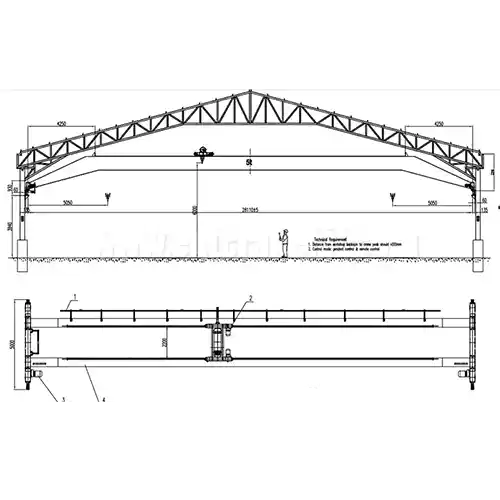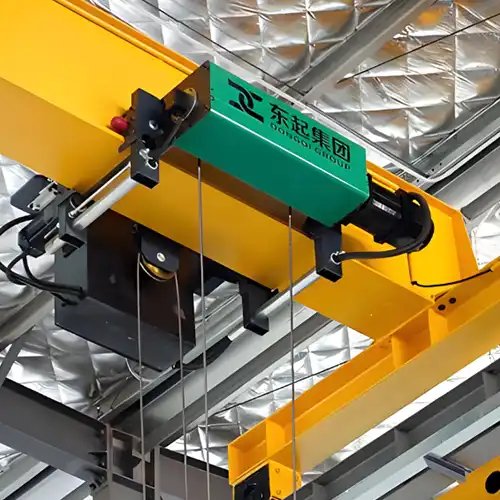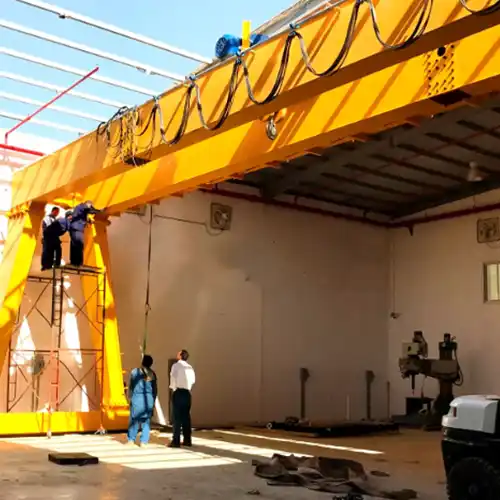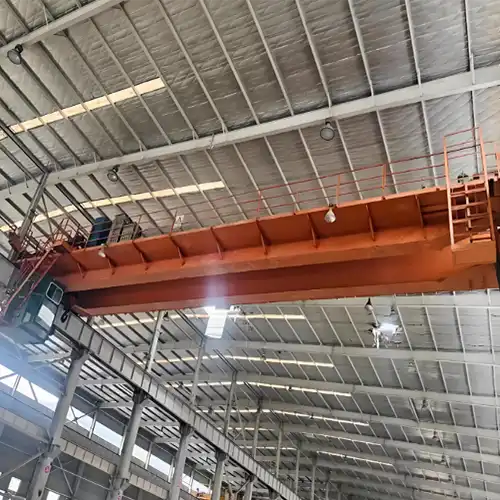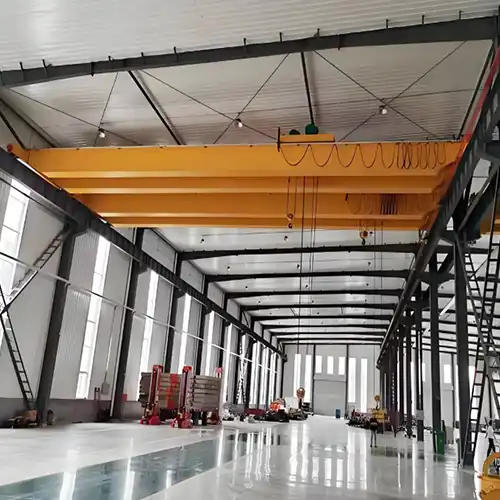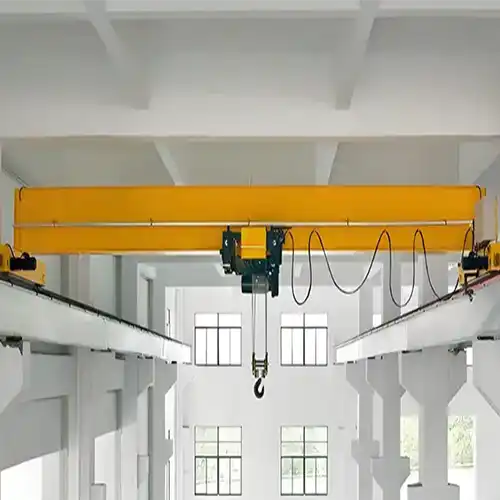Tailoring 5 Ton Overhead Crane Systems for Low-Ceiling Gable Roof Requirements in Bolivia
Custom-designed 5-ton cranes optimize lifting height, space efficiency, and performance in Bolivia's low-ceiling gable roof facilities.
Category: Low Built Cranes & Hoists
Your Trusted Overhead Crane Manufacturer & Supplier
Tailoring 5 Ton Overhead Crane Systems for Low-Ceiling Gable Roof Requirements in Bolivia
Overview of the Project
This case study highlights a 5 Ton Overhead Crane designed for a low-ceiling facility in Bolivia. The project involves customizing an overhead crane system to fit within a gable roof workshop where the ceiling height is limited. The primary challenge was to design a crane that could operate effectively in this restricted vertical space while still providing the necessary lifting capacity.
Given the space limitations, a standard crane design wouldn’t have been suitable. The crane needed to provide adequate lifting height and performance within the confines of a low ceiling. Therefore, a custom-designed crane system was the ideal solution to meet these specific requirements.
The Importance of Custom Crane Design
When a facility has unique constraints – such as a low ceiling – a custom crane design becomes crucial. Standard crane systems are often too tall, too bulky, or simply not suited to the available space. Custom cranes, on the other hand, can be designed specifically for these challenges, allowing businesses to optimize their available space without compromising on performance.
In this particular case, the 5 Ton Overhead Crane needed to fit within the limited ceiling height of the building while still achieving the desired lifting height. To address this challenge, the crane was designed with an arched structure. This design maximized the lifting height while maintaining a low profile, fitting the crane system perfectly within the facility’s ceiling constraints.
How Customized Systems Overcome Spatial Limitations
- Tailored to Fit the Space: A custom crane design ensures that the system is built to fit the exact dimensions of the facility. In this case, the crane was specifically designed to work within the low ceiling while still offering the required lifting height.
- Maximizing Efficiency: Custom cranes are optimized for the available space, making the most of every inch. This ensures that the crane can lift heavy loads efficiently without the need for costly modifications to the building.
- Meeting Operational Needs: A custom crane can be designed to handle the specific types of loads and tasks the facility needs, improving productivity and streamlining workflows.
Custom crane systems are essential for facilities with unique spatial constraints, such as low-ceiling environments. They provide a practical solution to maximize available vertical space while still offering the necessary lifting capacity. With tailored designs like the arched crane, businesses can meet their operational needs without requiring major structural changes to the building.
In the case of the 5 Ton Overhead Crane in Bolivia, this customized approach ensures that the crane operates efficiently within the restricted ceiling height, providing both operational flexibility and cost savings.
Project Background: Low-Ceiling Gable Roof Facility in Bolivia
Facility Characteristics and Constraints
The customer's facility in Bolivia is a gable roof workshop with a low ceiling height, creating a unique challenge for installing an overhead crane. The ceiling height is limited, which restricts the available space for standard crane systems that typically require higher vertical clearance. Despite these constraints, the facility needed a crane capable of lifting heavy loads to a significant height for efficient material handling.
This limited ceiling height presented a problem because traditional overhead cranes may not have been able to provide the necessary lifting capacity or headroom for the types of tasks the facility required. As a result, the crane system had to be carefully designed to fit within the restricted space while still maximizing the lifting height and ensuring efficient operation.
In addition to the low ceiling, the layout and the operational needs of the facility also played a crucial role in the crane’s design. The need to optimize the available space and make the most out of the vertical clearance was a key factor in designing a crane that met both space and functional requirements.
The Importance of Adapting the Crane Design
Given the facility's spatial limitations, adapting the crane design was essential to ensure the system could perform effectively within the available space. By customizing the crane to fit the exact dimensions of the building, it was possible to maximize the vertical space without sacrificing lifting power.
A customized crane system allowed for the design of a crane that could fit the low-ceiling gable roof while providing the required lifting height. This approach ensures that the building’s structural integrity remains intact, and no unnecessary adjustments or costly renovations are required to accommodate the crane. In essence, the crane design had to be engineered to optimize space efficiency while meeting the lifting needs of the customer.
Customer's Requirements
The customer’s key requirements were:
- Limited Building Height: The facility had a low ceiling, which posed a significant constraint for installing a crane system. The challenge was to design a crane that could fit within this limited space while still providing the required lifting height.
- Maximum Lifting Height: Despite the restricted ceiling height, the customer needed the crane to have as much lifting capacity as possible. The goal was to maximize the vertical clearance to ensure the crane could handle heavy loads and reach necessary heights for various operations.
- Cost-Effective Pricing: In addition to space and lifting capacity considerations, the customer required the crane to be cost-effective. The crane system needed to be affordable, both in terms of upfront costs and ongoing maintenance expenses, making value-for-money a primary concern.
By addressing these specific requirements, the custom-designed crane could be engineered to fit the space, meet the lifting demands, and stay within the customer’s budget.
Custom Design Approach for the 5 Ton Overhead Crane

Crane Specifications
The 5 Ton Overhead Crane for the customer in Bolivia is designed with the following specifications to meet the facility’s unique requirements:
- Crane Type: LH Series Double Girder Top Running Overhead Crane with CD/MD Electric Hoist. This type of crane features a robust double girder design, known for its strength and stability, ideal for lifting heavier loads efficiently and with precision. The electric hoist provides smooth and controlled lifting operations.
- Crane Span: 28.11m. The crane span, or the distance between the two rails that the crane runs on, is designed to cover the full width of the facility, allowing for maximum workspace coverage.
- Crane Lifting Height: 6m. Despite the limited ceiling height, the crane is designed to achieve a 6-meter lifting height, which is essential for the tasks that require lifting heavy loads to this specific height.
- Crane Power: 380V 50HZ 3P. The crane is powered by a standard 380V, 50Hz, 3-phase power supply, which ensures efficient energy usage and reliable operation within the facility's electrical system.
Tailoring to Low-Ceiling Requirements
The main challenge for this project was designing a crane that could operate effectively within the limited vertical space of the low-ceiling gable roof facility. Standard overhead cranes are typically too large or have components that protrude too far into the available headroom, limiting their ability to lift loads within tight ceiling spaces.
To solve this issue, the crane was specifically designed to address the low-ceiling constraints. One of the key solutions was the use of an arched design, which significantly increased the lifting height while maintaining a low profile.
The arched crane design allows for more vertical space above the crane’s lifting mechanism, enabling it to reach a greater height without needing additional headroom. This design feature was crucial in overcoming the facility's height limitations, ensuring that the crane could lift to the required height within the restricted ceiling space.
Design Features for Space Efficiency
Maximizing space efficiency in a low-ceiling environment requires careful consideration of several design elements. The crane was customized to ensure it made the best use of the available vertical space without compromising its functionality.
- Arched Shape Design The arched shape of the crane’s girder structure was a fundamental aspect of the design. This shape helps to maximize available headroom by shifting the crane’s lifting mechanism higher within the structure. The arch allows the crane to achieve its 6-meter lifting height while maintaining a compact and efficient profile, ensuring that the crane does not occupy excessive vertical space. This design enables the customer to make the most of the limited headroom in the facility.
- Low Headroom Hoisting System In addition to the arched design, a low headroom hoisting system was integrated into the crane. This system reduces the overall height of the crane’s hoist, further enhancing the lifting capacity without increasing the crane’s vertical profile. The hoist's compact design helps maintain operational efficiency without taking up too much headroom, making it ideal for facilities with ceiling constraints.
- Customized Crane Runways The crane’s runways were also customized to fit within the available ceiling height. The runways are designed to fit seamlessly into the building’s structure, ensuring that the crane can operate at full capacity without needing major alterations to the facility’s infrastructure. The customized runways ensure smooth operation while keeping the crane system compact and efficient.
The custom design of the 5 Ton Overhead Crane involved several key features tailored to meet the challenges of the low-ceiling gable roof facility in Bolivia. By utilizing an arched crane structure, a low headroom hoisting system, and customized crane runways, the crane was able to achieve the necessary lifting height of 6 meters while fitting within the limited vertical space. This thoughtful design approach ensured maximum space efficiency, allowing the crane to operate effectively without compromising on performance or safety.
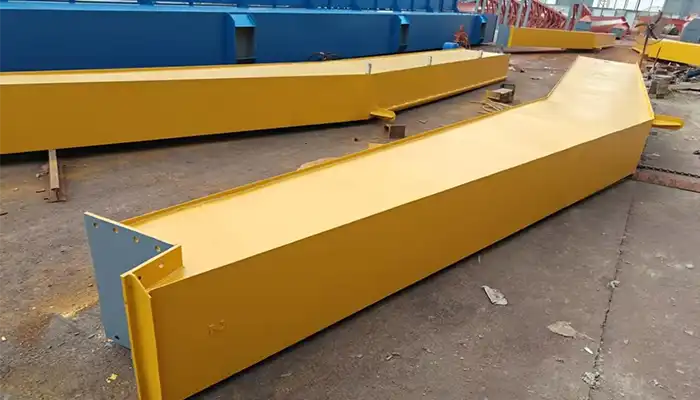
Arched girder of overhead crane system to increase lifting height
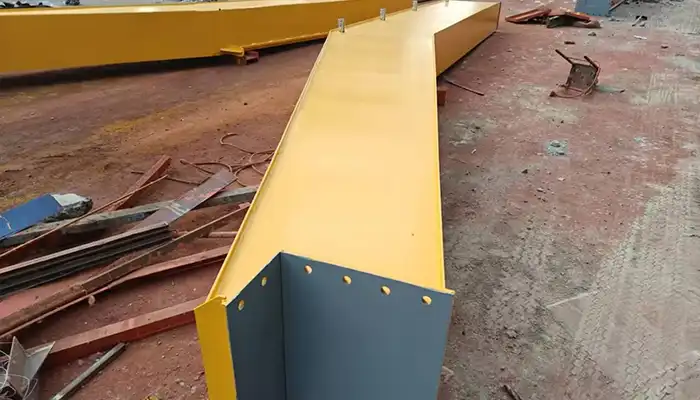
Customized bridge girder for crane system in the low headroom workshop
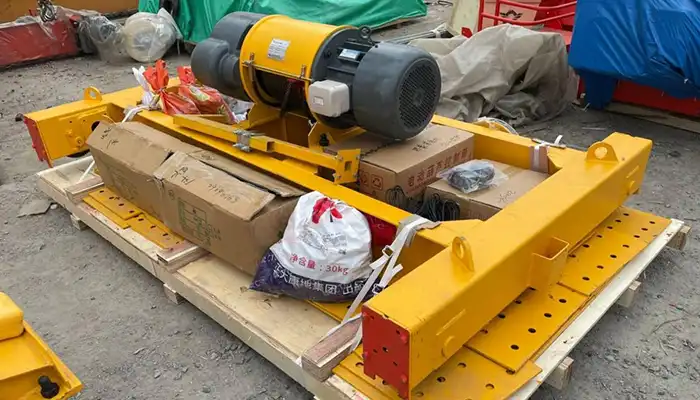
economical electric hoist trolley
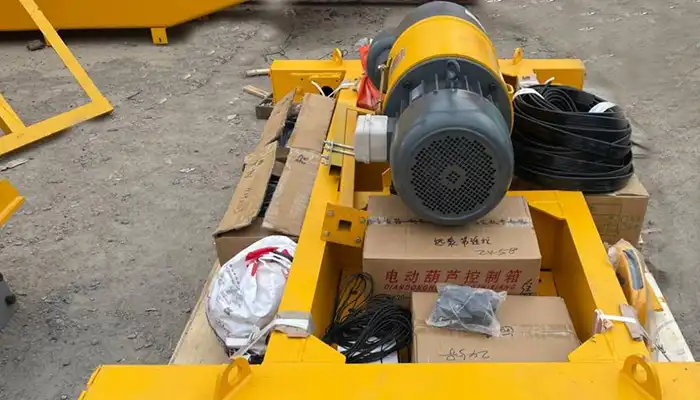
Electric wire rope hoist for the customized workshop for low ceiling facilities
Benefits of Custom-Designed Overhead Cranes
Maximizing Lifting Height in Low-Ceiling Facilities
Custom-designed overhead cranes are essential when working in low-ceiling environments, as they allow for the required lifting height despite the limited vertical space.
- Achieving Maximum Lifting Height: Custom cranes are specifically engineered to optimize lifting height without requiring excessive space or modifications to the building. In the case of the 5 Ton Overhead Crane in Bolivia, the arched design allowed the crane to reach a lifting height of 6 meters while staying within the facility's ceiling limits.
- Adapting to Facility Constraints: Custom cranes offer flexibility, allowing lifting heights to be tailored to the specific needs of the facility, whether it is for standard lifting or specialized tasks.
- Maximizing Operational Efficiency: By designing cranes to fit within the available space, operations are streamlined, ensuring that the crane can operate at its full capacity without sacrificing lifting height.
Improved Space Utilization
In facilities with limited ceiling height, maximizing the available space is crucial for overall efficiency. Custom cranes are designed to minimize their structural footprint while still providing the necessary lifting capacity.
- Arched Crane Design: The arched structure of the crane optimizes available headroom by shifting the lifting mechanism higher within the facility. This design maximizes vertical space, allowing for more efficient use of the facility’s clearance.
- Low-Headroom Hoisting Systems: Custom hoisting systems are integrated into the design to minimize the crane’s height while maximizing the lifting capacity. These systems ensure that the crane operates efficiently within tight spatial limits.
- Tailored Runways: Customized crane runways are designed to fit perfectly within the building’s existing structure, ensuring that the crane operates smoothly without wasting any available space.
Cost-Effectiveness
While custom cranes may require a higher initial investment, they provide significant cost savings over time by directly addressing the specific constraints of the facility and avoiding costly building modifications.
- No Need for Building Modifications: The custom crane’s design eliminates the need for extensive modifications to the facility. In the case of the Bolivian facility, the arched design and low-headroom hoisting system allowed the crane to fit within the existing structure, saving on construction costs.
- Long-Term Durability: Custom cranes are built to meet the specific needs of the facility, ensuring durability and reliability. This results in lower maintenance costs over time, as the crane is designed to perform optimally in the exact operational conditions.
- Lower Operating Costs: By reducing the need for extensive changes to the building and minimizing long-term maintenance, custom-designed cranes offer a cost-effective solution for businesses in the long run.
Impact on Operational Efficiency and Facility Performance
Optimized Workflow and Productivity
A custom-designed overhead crane plays a significant role in improving the overall operational efficiency of a facility, especially when working with limited vertical space in low-ceiling environments. By addressing the specific spatial limitations, a well-tailored crane design ensures that operations run smoothly and effectively.
- Maximizing Vertical Space: The arched crane design allows the lifting mechanism to be raised, maximizing the available headroom without requiring the building to be modified. This optimization of vertical space improves the workflow by providing enough clearance for the crane to perform efficiently while occupying minimal overhead space.
- Effective Handling of Materials and Loads: Even with a low ceiling, a custom crane can be engineered to handle heavy materials and loads effectively. The ability to design the crane for maximum lifting height within the available clearance means it can accommodate a wide range of tasks, from lifting heavy machinery to moving large loads, without sacrificing capacity.
- Improved Productivity: Custom cranes increase workflow efficiency by allowing operations to run seamlessly without the interruption of having to adjust the crane to fit in a restricted space. The crane's precise design ensures it can operate at optimal capacity, boosting productivity and minimizing downtime.
Enhanced Safety and Durability
Custom-designed cranes offer key safety benefits by addressing the unique demands of low-ceiling facilities. Safety is a critical concern in any industrial setting, and cranes must be specifically designed to withstand the conditions of each working environment.
- Safety Features for Low-Ceiling Environments: Custom cranes are built to meet the specific limitations of low-clearance environments, ensuring safe operation even in confined spaces. Features such as reinforced structures and low-headroom hoisting systems prevent the crane from becoming a hazard in tight spaces, reducing the risk of accidents.
- Reliability and Durability: To ensure long-term performance, cranes in low-ceiling environments are designed to be durable and reliable. For example, the Bolivian climate, which may involve high humidity or temperature fluctuations, requires cranes to be equipped with anti-corrosion treatments to protect against environmental factors that could lead to wear and tear.
- Reinforced Structures: The customized design of the crane includes reinforced components that add strength and reliability, ensuring the crane can handle heavy loads over a long period without compromising safety or performance.
- Long-Term Durability: With tailored anti-corrosion coatings and high-quality materials, custom cranes are built to withstand challenging environmental conditions, offering greater durability and fewer maintenance requirements. This is particularly important in regions like Bolivia, where cranes must operate in potentially harsh conditions.
Conclusion: The Value of Custom Crane Systems for Low-Ceiling Gable Roof Facilities
The 5 Ton overhead crane designed for the low-ceiling gable roof facility in Bolivia successfully addressed the facility’s unique operational challenges. By customizing the crane to fit within the limited vertical space, the design allowed the customer to achieve maximum lifting height, all while optimizing space utilization.
- Tailored Design: The crane's arched structure and low-headroom hoisting systems ensured that the facility could handle heavy loads without compromising operational efficiency.
- Meeting Unique Requirements: Custom cranes offer the flexibility to meet the specific demands of any facility, making it possible to adapt crane systems to a variety of spatial and operational constraints.
This case demonstrates how custom crane systems provide the perfect solution for facilities with low ceilings, proving that tailored designs can deliver superior performance even in challenging environments.
Long-Term Benefits for the Customer
Investing in a custom-designed crane system offers significant long-term value, especially when tailored to a facility's specific requirements. The benefits extend beyond just immediate space optimization and lifting capacity.
- Space Optimization: The arched crane design maximized the use of vertical space, ensuring the facility could use every inch of its headroom efficiently, and improved the overall workflow by removing the need for costly building modifications.
- Cost Efficiency: Although custom cranes might involve a slightly higher initial investment, they offer significant savings in the long run by eliminating the need for expensive building modifications, reducing maintenance costs, and improving crane lifespan.
- Enhanced Performance: Tailored solutions contribute to smoother operations, allowing for effective handling of materials, reducing downtime, and enhancing overall facility performance. Custom-designed cranes also ensure the crane can handle future needs without needing upgrades or significant changes to the system.
In conclusion, custom crane systems for low built workshops and facilities not only meet the immediate operational requirements but also deliver long-term benefits in terms of cost-efficiency, performance, and space management. This makes them a smart investment for any facility facing unique design challenges, like low-ceiling gable roof environments.
Main Projects
Related Products

Supplied three grab bucket crane kits to Indonesia, enhancing garbage handling efficiency with high load capacity and reliable performance.
Free consultation to Confirm Parameters & Specifications and Get
Latest Crane Price & Crane Rate.
- Types of overhead cranes : _______?
- Optional: Overhead travelling crane, goliath gantry crane,Slewing jib crane, Single girder or double girder crane,small portable crane or kbk crane, etc.
- Capacity of overhead crane: _______?
- Optional: 0.25ton, 0.5 ton, 1 ton, 2 ton, 3ton, 5 ton, 10 ton,15ton, 20ton, 25 ton, 30ton,35ton, up to 550ton, etc.
- Crane span & lifting height : _______?
- Crane travelling length : _____?
- Control of overhead crane:_______?
- Optional: pendant/ remote/cabin control
- Voltage supply of overhead crane:_____?
- Eg,: 380V50/60HZ,3Phase or others,etc.
- Application/usage of crane:_______?
- Eg,: Steel mill, ,injection mold, cement,stone, concrete,granite, general manufacturing, etc.
Just leave a message via the contact form and our hoist and crane engineer will contact you with in 24working hours.
Get In Touch
